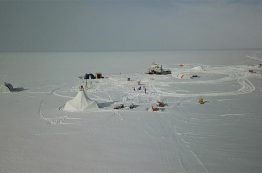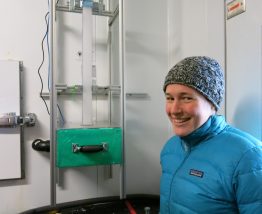The UW College of the Environment is pleased to announce that Eric Steig has agreed to serve as chair of the Department of Earth and Space Sciences (ESS), effective February 1, 2020, through June 30, 2023. Steig is a glaciologist and isotope geochemist who studies how the climate behaved in the past to learn what it can tell us both about the effects of climate change today, and how it will change in the future.
Read more »‘The blob,’ food supply squeeze to blame for largest seabird die-off
The common murre is a self-sufficient, resilient bird. Though the seabird must eat about half of its body weight in prey each day, common murres are experts at catching the small “forage fish” they need to survive. Herring, sardines, anchovies and even juvenile salmon are no match for a hungry murre. So when nearly one million common murres died at sea and washed ashore from California to Alaska in 2015 and 2016, it was unprecedented — both for murres, and across all bird species worldwide.
Read more at UW News »Barrels of ancient Antarctic air aim to track history of rare gas
Ancient air samples from one of Antarctica’s snowiest ice core sites may add a new molecule to the record of changes to Earth’s atmosphere over the past century and a half, since the Industrial Revolution began burning fossil fuels on a massive scale. While carbon dioxide and methane are well known, researchers at the University of Washington and the University of Rochester are part of a team working to trace a much rarer gas, present at less than one in a trillion molecules.
Read more at UW News »UW scientist to lead NASA field study of East Coast snowstorms
Snowstorms can wreak havoc across the United States, but especially on the East Coast. Snow is the least-understood form of precipitation, with major snowstorms among the most difficult weather events to forecast. Yet people rely on these forecasts to stay safe, plan travel routes and decide whether to close schools or businesses. To better understand large, disruptive snowstorms, a University of Washington atmospheric scientist will lead a NASA field campaign this winter to fly through major snowstorms along the East Coast.
Read more at UW News »How do we know so much about ancient climates?
Scientists know a lot about the Earth’s climate. Over the past sixty years, they have collected temperature and precipitation information, measured the amount of carbon dioxide in Earth’s atmosphere, and charted the changing weather. But what if we want to compare today’s climate to past climates—say, a million years ago or more? Traces of those past climates—referred to as paleoclimates—remain in rocks and ice as particles that once made up the ancient atmosphere, rain and soil.
Read more »





